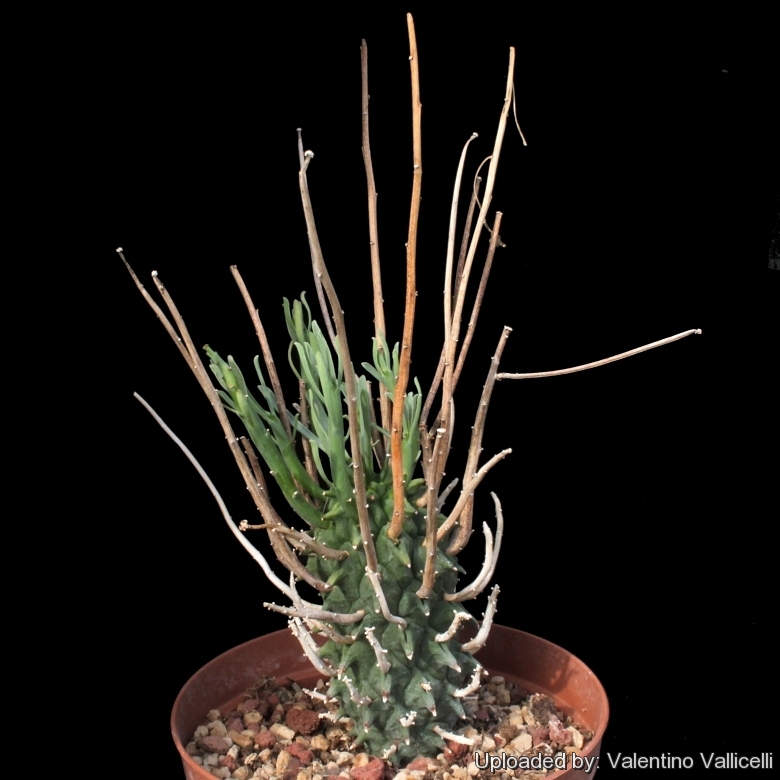Accepted Scientific Name: Euphorbia schoenlandii Pax
Jahresber. Schles. Ges. Vaterl. Cult. . 82(2): 24 1904 publ.

Euphorbia fasciculata Photo by: Valentino Vallicelli
In cultivation the name "fasciculata" is often used to indicate a form of E. schoenlandii with very long thin upright spines.
Origin and Habitat: Est cape, South Africa (fairly close to the South African west coast mainly on the Sand Veld the area right along the coast.)
Habitat: It is grows in open fields often on beach sand far enough from the present shoreline to support plant growth. Along with several species of aloe, spiky small-growing shrublike species and an array of clustering grape-like conophytums, Moraea species and other bulbs. The climate is characterized by winter rain and fog and summer drought.
Synonyms:
See all synonyms of Euphorbia schoenlandii
back
Accepted name in llifle Database:Euphorbia schoenlandii PaxJahresber. Schles. Ges. Vaterl. Cult. . 82(2): 24 1904 publ.Synonymy: 2
back
Description: Euphorbia fasciculata sensu N. E. Br. p.p. non Thunb. (= E. schoenlandii) is a small pickle shaped succulent srublet with prominent spiny tubercles, sometimes resembling a green pineapple, usually single stemmed but may branch with age.
Stem: Up to 20 cm thick and 100(-130) cm tall, upright growing and club-shaped with large conical tubercles up to 12 mm long.
Spines: 2,5-5 cm long (but occasionally up to 15 cm in the so called "fasciculata" type), the “spines” are only the stout, woody, withered remains of fertile peduncles which endure.
Flowers: Cyathia (8 mm Ø) solitary or in simple cymes, arising above the spines, peduncles up to 2,5 cm long with a few 2-3 cm long scattered and deciduous bracts. Nectar glans oblong, margin with 3 to 8 entire or bifid linear, separated, processes up to 1,5 mm long.
Fruits: Globose to sub-globose up to 6 mm wide, sub-sessile.
Seeds: Oblong up to 4 mm wide.
Subspecies, varieties, forms and cultivars of plants belonging to the Euphorbia schoenlandii group
Bibliography: Major references and further lectures
1) Urs Eggli “Illustrated Handbook of Succulent Plants: Dicotyledons” Springer, 2002
2) Hermann Jacobsen “A handbook of succulent plalnts: Abromeitiella to Euphorbia” Blandford Press, 1960
3) James Cullen, Sabina G. Knees, H. Suzanne Cubey “The European Garden Flora Flowering Plants: A Manual for the Identification of Plants Cultivated in Europe, Both Out-of-Doors and Under Glass” Cambridge University Press, 11/ago/2011
4) Doreen Court “Succulent Flora of Southern Africa” CRC Press, 01/giu/2000
5) Alain Campbell White, Robert Allen Dyer, Boyd L. Sloane “The succelent Euphorbisae (southern Africa)” Abbey garden press, 1941
6) Werner Rauh “Cultivation and Description of Selected Succulent Plants Other Than Cacti” Smithsonian Institution Press 1984
7) Gibbs Russell, G. E., W. G. Welman, E. Reitief, K. L. Immelman, G. Germishuizen, B. J. Pienaar, M. v. Wyk & A. Nicholas. “List of species of southern African plants.” Mem. Bot. Surv. S. Africa 2(1–2): 1–152(pt. 1), 1–270(pt. 2). 1987.
Cultivation and Propagation: Like a sunny position. It does best in a mineral soil, good drainage is essential. Water sparingly during the summer months and keep dry in winter. It is a slow growing long lived plant and once established, it will be content in its position and with its soil for years. It can tolerate moderate shade, and a plant that has been growing in shade should be slowly hardened off before placing it in full sun as the plant will be severely scorched if moved too suddenly from shade into sun.
Propagation: It is propagated from seed sown during spring or summer. Germination occurs within 3 weeks, but it can be reproduced by cuttings as well (if available). Flowering can be achieved within 5-8 years.










